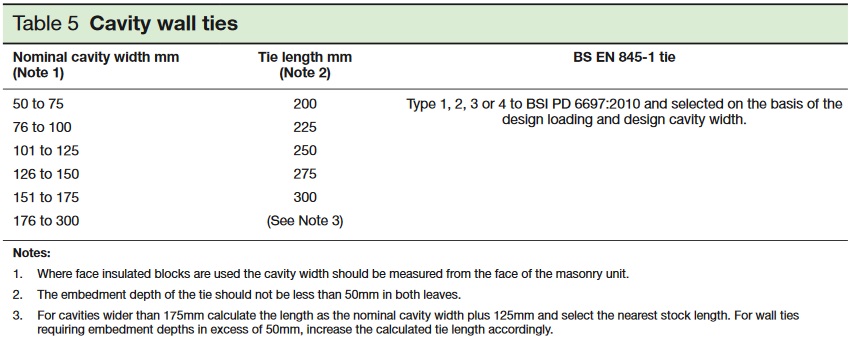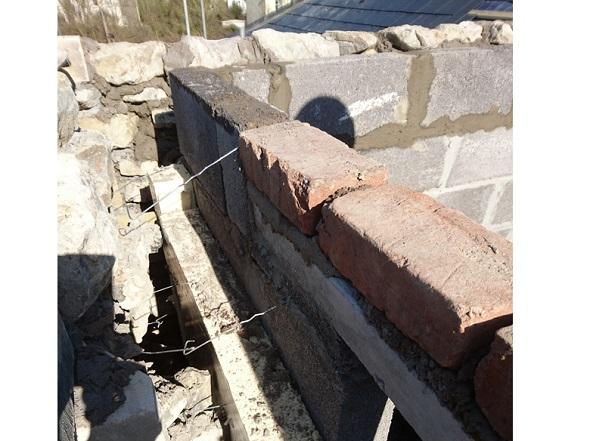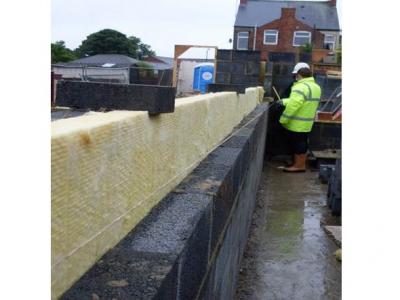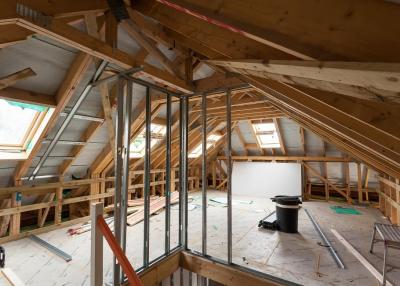How to use cavity wall ties correctly
Incorrect use of cavity wall ties is one of the common problems found on site by our building control surveyors. The wrong choice of cavity wall tie, not enough ties, and wrong detailing around openings are frequently spotted.
The image above shows how not to do it; hooking wall ties together, using masonry chunks to retain the insulation and not maintaining the cavity width will all lead to cold bridging and dampness. There’s no surprise that this wall had to be demolished and rebuilt.
Here are some easy steps to get your wall ties right:
- The length of wall tie needed is specified in table 5 of Approved Document A of the Building Regulations, reproduced below.

- You need two and a half wall ties per square metre of masonry. The maximum horizontal spacing is 900mm and the maximum vertical spacing is 450mm. That’s why cavity wall insulation boards usually have a maximum dimension on the short edge of 450mm.
- Set each wall tie a minimum of 50mm into both masonry leaves.
- Lay the wall ties to a slight ‘outward’ fall to prevent water passing to the inner leaf.
- Only use insulation retaining clips that are compatible with your tie.
- Change the wall tie pattern around openings such as windows, doors, roof verges and movement joints. Here the vertical spacing is reduced to a maximum 300mm and should be within 225mm of the opening. So realistically, that’s a wall tie every course of blocks within 225mm of the opening, which means you need to carefully cut (and clip) the insulation.
- Cavity wall ties should be stainless steel.
Follow these simple rules and you’ll meet the Building Regulation requirements every time.
Further reading
Also read Avoid backfalling wall ties
Please Note: Every care was taken to ensure the information was correct at the time of publication. Any written guidance provided does not replace the user’s professional judgement. It is the responsibility of the dutyholder or person carrying out the work to ensure compliance with relevant building regulations or applicable technical standards.
Sign up to the building bulletin newsletter
Over 48,000 construction professionals have already signed up for the LABC Building Bulletin.
Join them and receive useful tips, practical technical information and industry news by email once every 6 weeks.
Subscribe to the Building Bulletin



Comments
(No subject)
Submitted 7 years 3 months ago
Reply
Submitted 7 years 3 months ago
The Approved Document to Part E recommends that wall ties for separating walls should be as described for ‘type A’. This relates to transmission of vibration. There is a need to ensure the choice of wall ties satisfies structural requirements suitable for the cavity width while being aware of the sound transmission properties. See AD E for description of type A wall ties.
Ultimately the wall must satisfy either the construction described for a licenced Robust Detail or be subject to a pre-completion test to demonstrate compliance.
Barry,
LABC Director of Technical Policy
Wall Ties
Submitted 6 years 7 months ago
Reply to: Wall Ties
Submitted 6 years 7 months ago
The reason is to ensure adequate bonding between mortar and the course of brick above and below.
Kind regards,
Barry, LABC
76mm Cavity spacing
Submitted 6 years 5 months ago
Cheers
Reply to: 76mm Cavity spacing
Submitted 6 years 4 months ago
Having checked earlier versions of this article I'm afraid that we cannot find the table you're referring to.
Regards,
LABC
Wall ties on corners
Submitted 5 years 6 months ago
I have been pulled up on site for not putting enough wall ties at internal and external corners. I am being told to put a tie every course either side of the corner. Is this correct?
Many thanks
Wall ties
Submitted 5 years 3 months ago
[I believe that the British standard requires ties at 300mm centres at reveals.]
Wall ties on corners
Submitted 5 years 2 months ago
Remedial Wall Ties - Mid Terrace
Submitted 5 years 5 months ago
Do you have any suggestions as to the approach I should take regarding the repair. I am concerned that if the properties on either side do not repair their walls I may still have a problem.
Add new comment